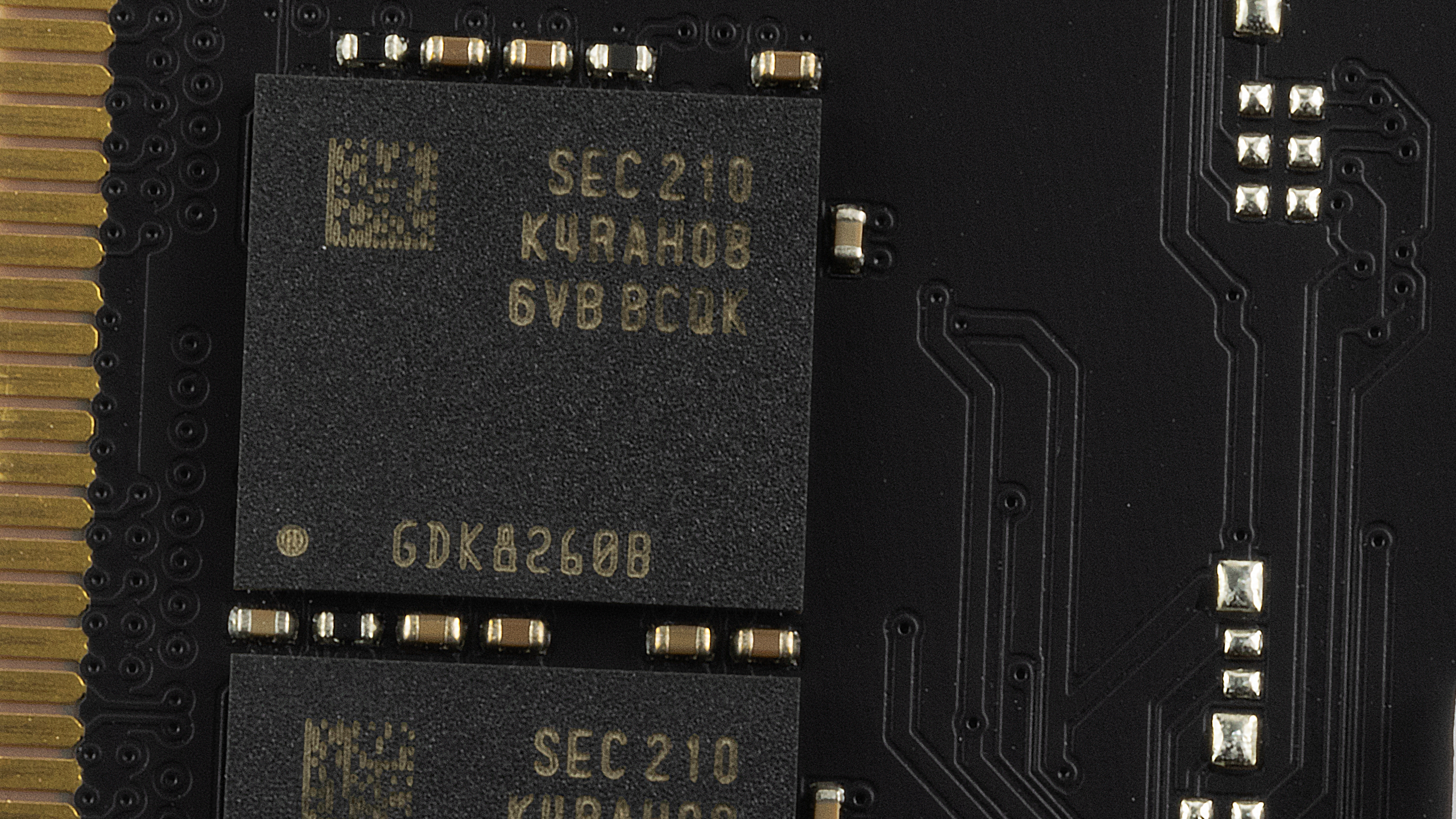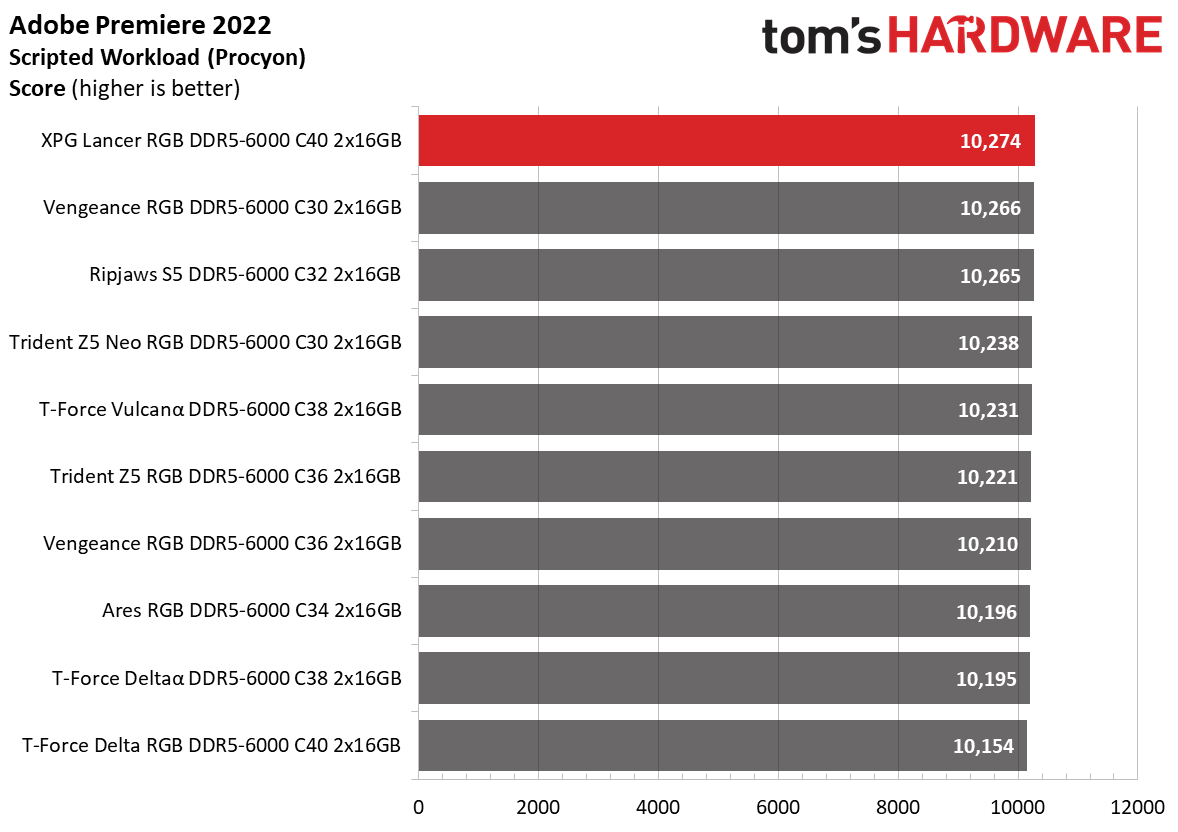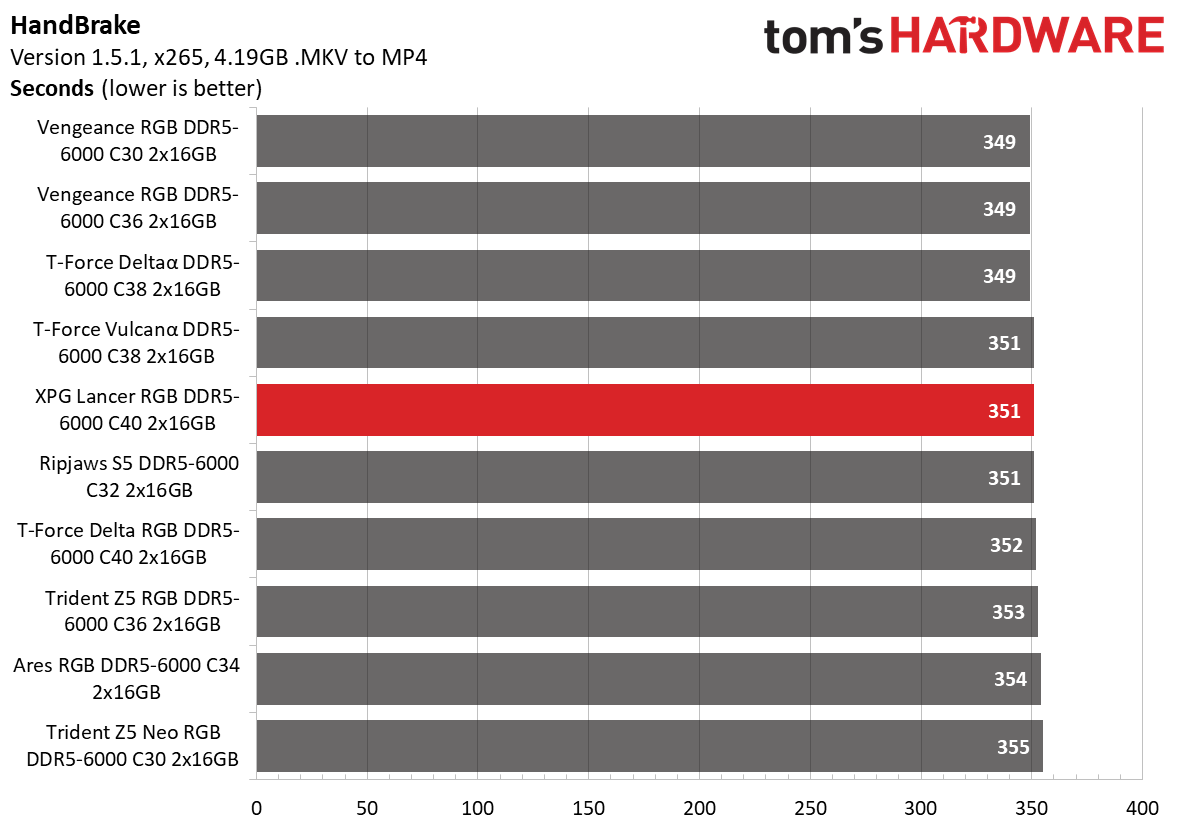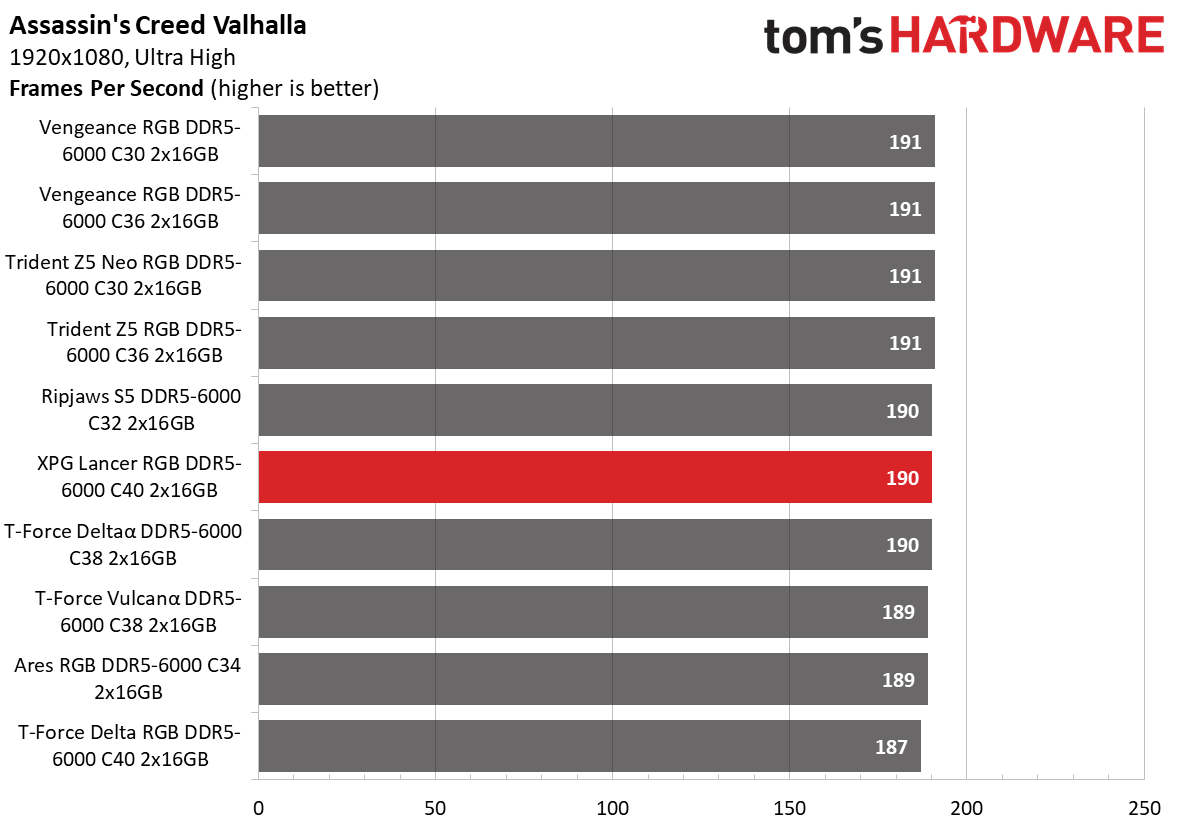Tom's Hardware Verdict
Despite supporting Intel XMP 3.0 and AMD EXPO profiles, the Adata XPG Lancer RGB DDR5-6000 C40 has proven to perform better on AMD systems.
Pros
- +
Above-average AMD performance
- +
Intel XMP 3.0 and AMD EXPO support
- +
Overclocks well
Cons
- -
Slow on the Intel platform
- -
A bit pricey
Why you can trust Tom's Hardware
The XPG Lancer RGB DDR5-6000 C40 doesn't look impressive on paper, but the memory kit isn't shy to take on the best RAM around. AMD's adoption of DDR5 on the company's latest Zen 4 desktop consumer platform has created a segmentation among DDR5 memory kits. On one end, you have the Intel XMP 3.0 memory kits, and on the other, the AMD EXPO memory kits. Then you have the fence-sitters, such as the Adata memory kit in this review, that embraces both technologies. There's nothing wrong with it. Companies want to cover all the bases, and in Adata's case, the vendor ensures that the memory kit will appeal to users on both the Intel and AMD platforms.



The XPG Lancer RGB has a black aluminum heat spreader with a brushed finish. It's also available in white, but will depend on the SKU. There's a geometric look to the aesthetics, with diagonal lines that help make the design stand out. The memory is 40mm (1.57 inches) tall, so we don't expect it to pose a problem for CPU air coolers.
Like many high-end DDR5 kits, the XPG Lancer RGB possesses n RGB diffuser with vivid lighting. The triangular design of the top of the heat spreader exposes a portion of the RGB diffuser. As usual, two methods exist to control the XPG Lancer RGB's illumination. You can use the XPG Prime lighting control software, which you can download from Adata's website, or the software that controls the lighting on your motherboard. Compatibility includes Asus Aura Sync, Gigabyte RGB Fusion, MSI Mystic Light Sync, and ASRock Polychrome Sync.


Each memory module is 16GB in capacity and features a single-rank design. It comprises eight Samsung K4RAH086VB-BCQK (B-die) integrated circuits (ICs), each adding 2GB for 16GB per memory module. It certainly comes as a surprise that Adata uses Samsung B-die ICs, as many vendors have inclined toward SK hynix's ICs for their high overclocking margins. As for the power management IC (PMIC), we discovered the "0D=9C B4F" unit from renowned manufacturer Richtek.
The XPG Lancer RGB runs at DDR5-4800 with 40-40-40-77 timings and continues to do so until you set it up. The memory comes with one Intel XMP 3.0 and one AMD EXPO profile. Both profiles will get the memory running at DDR5-6000 and configure the timings to 40-40-40-76 and the DRAM voltage to 1.35V. See our PC Memory 101 feature and How to Shop for RAM story for more timings and frequency considerations.
Comparison Hardware
| Memory Kit | Part Number | Capacity | Data Rate | Primary Timings | Voltage | Warranty |
|---|---|---|---|---|---|---|
| Corsair Vengeance RGB DDR5 | CMH32GX5M2B6000Z30 | 2 x 16GB | DDR5-6000 (EXPO) | 30-36-36-76 (2T) | 1.40 | Lifetime |
| G.Skill Trident Z5 Neo RGB | F5-6000J3038F16GX2-TZ5NR | 2 x 16GB | DDR5-6000 (EXPO) | 30-38-38-96 (2T) | 1.35 | Lifetime |
| G.Skill Ripjaws S5 | F5-6000J3238F16GX2-RS5K | 2 x 16GB | DDR5-6000 (XMP) | 32-38-38-96 (2T) | 1.35 | Lifetime |
| Lexar Ares RGB | LD5FU016G-R6000GDGA | 2 x 16GB | DDR5-6000 (XMP & EXPO) | 34-38-38-76 (2T) | 1.30 | Lifetime |
| G.Skill Trident Z5 RGB | F5-6000U3636E16GX2-TZ5RS | 2 x 16GB | DDR5-6000 (XMP) | 36-36-36-76 (2T) | 1.30 | Lifetime |
| Corsair Vengeance RGB DDR5 | CMH32GX5M2D6000C36 | 2 x 16GB | DDR5-6000 (XMP) | 36-36-36-76 (2T) | 1.35 | Lifetime |
| TeamGroup T-Force Deltaα RGB | FF7D532G6000HC38ADC01 | 2 x 16GB | DDR5-6000 (EXPO) | 38-38-38-78 (2T) | 1.25 | Lifetime |
| TeamGroup T-Force Vulcanα DDR5 | FLABD532G6000HC38ADC01 | 2 x 16GB | DDR5-6000 (EXPO) | 38-38-38-78 (2T) | 1.25 | Lifetime |
| Adata XPG Lancer RGB | AX5U6000C4016G-DCLARBK | 2 x 16GB | DDR5-6000 (XMP & EXPO) | 40-40-40-76 (2T) | 1.35 | Lifetime |
| TeamGroup T-Force Delta RGB | FF3D516G6000HC40ABK | 2 x 16GB | DDR5-6000 (XMP) | 40-40-40-80 (2T) | 1.35 | Lifetime |


The Intel system runs the Core i9-13900K on the MSI MEG Z690 Unify-X with the 7D28vAA firmware. In contrast, the AMD system pairs the Ryzen 7 7700X with the MSI MPG X670E Carbon WiFi changed to the 7D70v176 firmware. The Corsair CUE H100i Elite LCD liquid cooler keeps our Raptor Lake and Zen 4 processor operating temperatures under check.
The MSI GeForce RTX 4080 16GB Gaming X Trio tackles the more graphics-intensive workloads, ensuring that there isn't a graphics bottleneck in our gaming RAM benchmarks. The Windows 11 installation, benchmarking software, and games reside on Crucial's MX500 SSDs. Meanwhile, the Corsair RM1000x Shift ATX 3.0 power supply provides our systems with clean and abundant power, directly feeding the GeForce RTX 4080 with a native 16-pin (12VHPWR) power cable. Lastly, the Streacom BC1 open-air test bench is vital to organizing our hardware.
Get Tom's Hardware's best news and in-depth reviews, straight to your inbox.
Intel Performance




















The XPG Lancer RGB memory kit was the slowest on the Intel platform. The memory kit's best highlight was from the Adobe Premiere workload, where it came in the first position. The XPG Lancer RGB outperformed all the other DDR5-6000 memory kits in that specific benchmark.
AMD Performance




















The XPG Lancer RGB's saving grace resided on the AMD platform. Surprisingly, the memory kit finished in third place on the application performance chart. It delivered higher performance than some of its rivals with better timings, such as the Corsair Vengeance RGB DDR5-6000 C36 or the Teamgroup T-Force Deltaα DDR5-6000 C38.
Overclocking and Latency Tuning



The XPG Lancer RGB was one of three DDR5-6000 memory kits that could hit DDR5-6600, with the other two being the Teamgroup T-Force Deltaα DDR5-6000 C38 and Lexar Ares RGB DDR5-6000 C34. It was incredible since the two aforementioned memory kits use SK hynix ICs that typically overclock better than competing solutions. At DDR5-6600 with 1.4V, we got the timings as tight as 36-36-36-76.
Lowest Stable Timings
| Memory Kit | DDR5-6000 (1.4V) | DDR5-6200 (1.4V) | DDR5-6400 (1.4V) | DDR5-6600 (1.4V) |
|---|---|---|---|---|
| Adata XPG Lancer RGB DDR5-6000 C40 | 34-34-34-74 (2T) | N/A | N/A | 36-36-36-76 (2T) |
| Lexar Ares RGB DDR5-6000 C34 | 30-36-36-76 (2T) | N/A | N/A | 34-40-40-76 (2T) |
| TeamGroup T-Force Deltaα DDR5-6000 C38 | 36-36-36-76 (2T) | N/A | N/A | 38-38-38-78 (2T) |
| G.Skill Ripjaws S5 DDR5-6000 C32 | 28-34-34-74 (2T) | N/A | 32-38-38-96 (2T) | N/A |
| Corsair Vengeance RGB DDR5-6000 C36 | 34-34-34-74 (2T) | N/A | 38-38-38-78 (2T) | N/A |
| TeamGroup T-Force Vulcanα DDR5-6000 C38 | 36-36-36-76 (2T) | N/A | 38-38-38-78 (2T) | N/A |
| TeamGroup T-Force Delta RGB DDR5-6000 C40 | 38-38-38-78 (2T) | N/A | 40-40-40-82 (2T) | N/A |
| Trident Z5 Neo RGB DDR5-6000 C30 | 30-36-36-96 (2T) | 30-38-38-96 (2T) | N/A | N/A |
| G.Skill Trident Z5 RGB DDR5-6000 C36 | 36-33-33-73 (2T) | 36-36-36-76 (2T) | N/A | N/A |
The memory kit could do DDR5-6000 with 34-34-34-74 timings just fine. We only had to increase the DRAM voltage by 0.05V. Samsung B-die ICs continue to show tighter timings. For example, the Teamgroup T-Force Delta RGB DDR5-6000 C40 and Teamgroup T-Force Vulcanα DDR5-6000 C38 with SK hynix ICs wouldn't stabilize below 36-36-36-76 at DDR5-6000.
Bottom Line
There aren't many DDR5 memory kits equipped with Intel XMP 3.0 and AMD EXPO profiles. This gives the XPG Lancer RGB DDR5-6000 C40 a somewhat advantage over the competition. However, the memory revealed a preference for AMD platforms, as it had a lackluster performance on the Intel platform. Overclocking wasn't bad, either. Armed with Samsung B-die ICs, the memory kit achieved similar results to its rivals with the ever-popular SK hynix ICs.
The XPG Lancer RGB DDR5-6000 C40 currently sells for $99.50. Yes, it's a bit expensive for a DDR5-6000 C40 memory kit by today's standards. There are a handful of DDR5-6000 offerings with better timings at the sub-$100 mark. However, the XPG Lancer RGB DDR5-6000 C40's superb AMD performance, striking aesthetics, and good overclocking potential compensate for the moderately higher price tag.
- MORE: Best RAM
- MORE: DDR DRAM FAQs And Troubleshooting Guide
- MORE: All Memory Content

Zhiye Liu is a news editor, memory reviewer, and SSD tester at Tom’s Hardware. Although he loves everything that’s hardware, he has a soft spot for CPUs, GPUs, and RAM.
-
gg83 Is Samsung b-die the best? I see it mentioned when talking about good overclocking maybe? Does SK or Micron make a better or competitive option?Reply -
Hotrod2go When I had my Ryzen 7-7700 on Gigabyte B650 Aorus Elite board with Samsung B-die, I could get stable in MemTestPro with over 600% coverage using 32-36-36-88 timings for 6400.Reply
